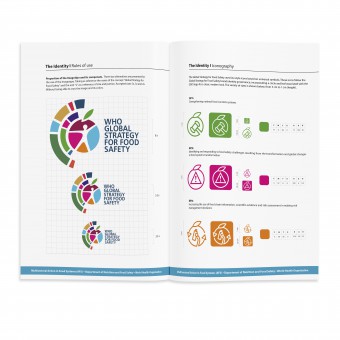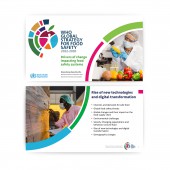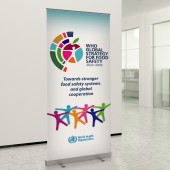Safer Food Editorial Design by Alberto March |
Home > Winners > #151038 |
 |
|
||||
| DESIGN DETAILS | |||||
| DESIGN NAME: Safer Food PRIMARY FUNCTION: Editorial Design INSPIRATION: The editorial brand pieces were inspired by the increasing importance of food safety in the supply chain. 1. The safety of food products has become more challenging due to the global nature of the food supply chain. 2. Food safety incidents, like outbreaks of foodborne illnesses, have shown the risks of consuming unsafe food. 3. Food safety is crucial for public health and can impact millions worldwide. 4. New technologies for detecting and monitoring foodborne pathogens have improved food safety measures. 5. Establishing international agreements and standards, such as the Codex Alimentarius, provides a global framework for ensuring food safety. UNIQUE PROPERTIES / PROJECT DESCRIPTION: The design meets the objective of conveying and recognizing food safety information. The process of creating the report's content received advice from the Technical Advisory Group on Food Safety: Safer Food for Better Health. The five strategies described in the report incorporate input gathered through a comprehensive consultation process that involves member states and governmental institutions, United Nations agencies and other intergovernmental organizations, academic institutions, and non-governmental organizations. OPERATION / FLOW / INTERACTION: The report is available in an interactive PDF for web use and a printed version. PROJECT DURATION AND LOCATION: March 2022 to March 2023, Geneva-Switzerland-Barcelona, Spain. The image for the program's brand name, Global Strategy for Food Safety, and the report's cover and layout design took one year to create. This included searching for the right image to represent each segment, creating icons and figures, and making corrections per the editors' suggestions. |
PRODUCTION / REALIZATION TECHNOLOGY: 1. WHO global strategy for food safety: offset printing on paper. 2. PDF version for web purposes. 3. Summary of the report: PDF version for web purposes. 4. PowerPoint presentation. 5. Rollup Banners for conferences. 6. Design of the brand identity for the logo image and iconography. Adobe programs used: Adobe InDesign, Illustrator and Photoshop. SPECIFICATIONS / TECHNICAL PROPERTIES: Print version: size A4, full color. 76 pages. Web version: A4-sized with interactive features. Roll-up Banners for conferences: 200 cm x 80 cm. TAGS: food safety, global strategy, timeframe, WHO, healthy food, food safety, alberto march, emergency response systems, global food systems RESEARCH ABSTRACT: Methodology used: User research helps design a user-friendly product by understanding the target audience's needs, behaviours, and preferences. Market research was conducted to understand industry trends and design a relevant and appealing report for the target audience. Visual research was conducted to analyze design trends, styles, and techniques in similar reports worldwide. Ethnographic research was conducted to understand the cultural and social context in which the report will be used, resulting in a culturally sensitive and relevant design for the target audience. Design steps: The first step was to create a logo for the program that incorporated semi-circle bands to represent data analysis and healthy food consumption. The client also wanted the colour palette to align with the Sustainable Development Goals (SDGs) related to the report's content. The second step was to create five icons to represent the main core of the report consistent with the five strategies. Each strategy aims to build proactive, forward-looking, evidence-based, people-centred, cost-effective food safety systems with coordinated governance and adequate infrastructure.* The third step was to create the cover's report to convey a robust natural and organic food environment. Step four involved designing the report layout, using the brand's colour palette to differentiate sections and reinforce its identity. I created internal covers with colours linked to the logo's palette to distinguish chapters. The fifth step involved creating PowerPoint slides aligned with the report design and logo and a roll-up banner for conferences worldwide. *(Detail information on the design process step can be found on the PDF) CHALLENGE: The primary difficulty was to select a suitable layout design structured by sections, colours, and relevant photographs that could effectively depict the specific themes mentioned in each section of the report. The objective was to engage the audience and encourage them to take an interest in the proposed policies and actions in food safety. Searching for photographs was a challenge primarily because each photo had to be linked with a specific chain of food systems related to scientific fields and surveillance programmes. Food safety is a primary determinant of human health. Access to safe, nutritious food is a fundamental human right. Since its establishment in 1948, the World Health Organization (WHO) has been dedicated to reducing the impact of foodborne diseases on global health. WHO has played a leading role in assessing global food safety, aiding countries in establishing or strengthening national surveillance systems for food-borne diseases, promoting control and prevention strategies through education programs, and raising international awareness. ADDED DATE: 2023-03-25 10:17:18 TEAM MEMBERS (1) : IMAGE CREDITS: Cover and layout design: Alberto March Cover image: DisobeyArtPh; Licensee: Alberto March Slide PPT #1: AlexRaths; Licensee: Alberto March Slide PPT #2: ckstockphoto; Licensee: Alberto March Page 11, #1: Seventyfourimages; Licensee: Alberto March Copyright content: World Health Organization PATENTS/COPYRIGHTS: WHO global strategy for food safety 2022–2030: towards stronger food safety systems and global cooperation. ISBN 978-92-4-006120-0 (electronic version) ISBN 978-92-4-006121-7 (print version) © World Health Organization 2022 Some rights reserved. This work is available under the Creative Commons Attribution-NonCommercial-ShareAlike 3.0 IGO licence (CC BY-NC-SA 3.0 IGO; https://creativecommons.org/licenses/by-nc-sa/3.0/ igo). Layout and design: Alberto March |
||||
| Visit the following page to learn more: https://bit.ly/3PeR6y8 | |||||
| AWARD DETAILS | |
 |
Safer Food Editorial Design by Alberto March is Winner in Print and Published Media Design Category, 2023 - 2024.· Press Members: Login or Register to request an exclusive interview with Alberto March. · Click here to register inorder to view the profile and other works by Alberto March. |
| SOCIAL |
| + Add to Likes / Favorites | Send to My Email | Comment | Testimonials | View Press-Release | Press Kit |







